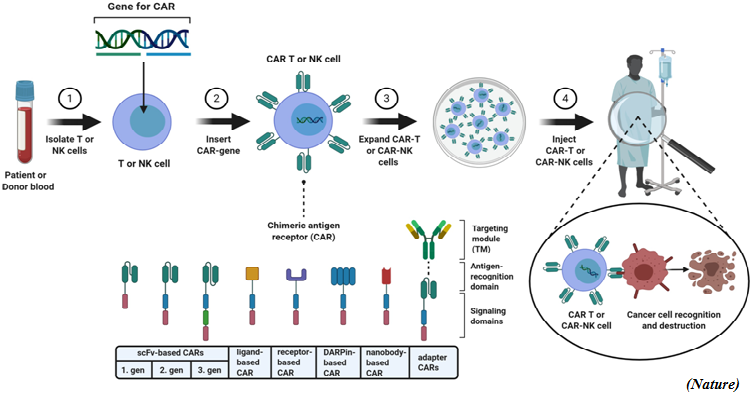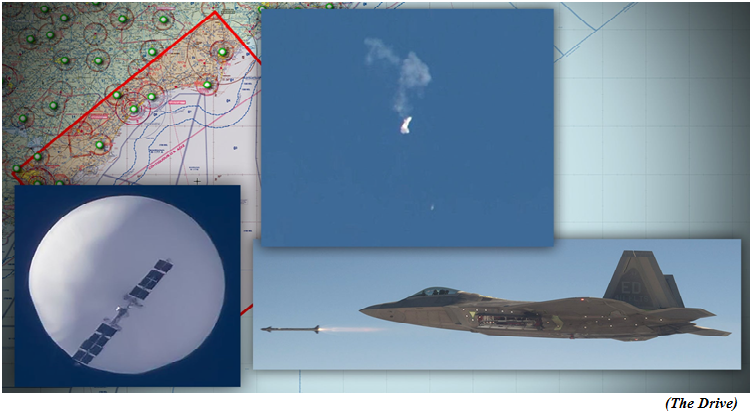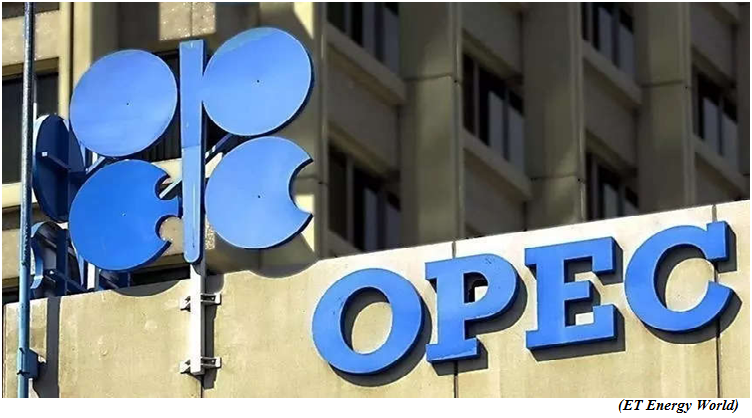CAR T cell therapy the next step towards a holistic treatment of cancer (GS Paper 3, Science and Tech)

Why in news?
- The three major forms of treatment for any cancer are surgery (removing the cancer), radiotherapy (delivering ionising radiation to the tumour), and systemic therapy (administering medicines that act on the tumour).
- Surgery and radiotherapy have been refined significantly over time whereas advances in systemic therapy have been unparalleled.
- A new development on this front, currently holding the attention of many researchers worldwide, is the CAR T-cell therapy.
How has systemic therapy evolved?
- Systemic therapy’s earliest form was chemotherapy; when administered, it preferentially acts on cancer cells because of the latter’s rapid, unregulated growth and poor healing mechanisms.
- Chemotherapeutic drugs have modest response rates and significant side-effects as they affect numerous cell types in the body.
- The next stage in its evolution was targeted agents, also known as immunotherapy. Here the drugs bind to specific targets on the cancer or on the immune cells that help the tumour grow or spread.
- This method often has fewer side-effects as the impact on non-tumour cells is limited. However, it is effective only against tumours that express these targets.
What are CAR T-cells?
- Chimeric antigen receptor (CAR) T-cell therapies represent a quantum leap in the sophistication of cancer treatment.
- Unlike chemotherapy or immunotherapy, which require mass-produced injectable or oral medication, CAR T-cell therapies use a patient’s own cells. They are modified in the laboratory to activate T-cells, a component of immune cells, to attack tumours.
- These modified cells are then infused back into the patient’s bloodstream after conditioning them to multiply more effectively.
- The cells are even more specific than targeted agents and directly activate the patient’s immune system against cancer, making the treatment more clinically effective. This is why they’re called ‘living drugs’.
How does it work?
Where is it used?
- As of today, CAR T-cell therapy has been approved for leukaemias (cancers arising from the cells that produce white blood cells) and lymphomas (arising from the lymphatic system).
- These cancers occur through the unregulated reproduction of a single clone of cells, that is, following the cancerous transformation of a single type of cell, it produces millions of identical copies. As a result, the target for CAR T-cells is consistent and reliable.
- CAR T-cell therapy is also used among patients with cancers that have returned after an initial successful treatment or which haven’t responded to previous combinations of chemotherapy or immunotherapy.
- The potential side-effects are also significant, associated with cytokine release syndrome (a widespread activation of the immune system and collateral damage to the body’s normal cells) and neurological symptoms (severe confusion, seizures, and speech impairment).
How widespread is its use?
- The complexity of preparing CAR T-cells has been a major barrier to their use. The first clinical trial showing they were effective was published almost a decade ago; the first indigenously developed therapy in India was successfully performed only in 2022.
- The technical and human resources required to administer this therapy are also considerable. Treatments in the U.S. cost more than a million dollars.
- Trials are underway in India, with companies looking to indigenously manufacture CAR T-cells at a fraction of the cost. The preliminary results have been encouraging.
The saga of a spy balloon in US airspace
(GS Paper 2, International Relation)
Why in news?
- Recently, the U.S. shot down a Chinese ‘spy’ balloon, days after the surveillance device was first spotted over American airspace, bringing the dramatic saga to a climax and dealing yet another blow to the already strained diplomatic relation between the two sides.

What happened?
- Reports of a massive white orb floating high above the U.S. State of Montana captured global attention.
- Ending speculations, American defence and military officials confirmed that the reconnaissance balloon had travelled from China, entered the air defence zone north of the Aleutian Islands on January 28, subsequently moved over land across Alaska and into Canadian airspace and crossed back into the U.S. over Idaho.
- President was briefed on the matter and the military considered shooting down the balloon which Pentagon believed was a Chinese surveillance tool carrying sensors and equipment to collect information about military and other strategic sites like Montana, which is home to one of the nation’s three nuclear missile silo fields.
- China insisted that the balloon was an errant civilian airship used mainly for meteorological research that went off course due to winds.
How was the balloon shot down?
- Ahead of the mission, NASA assessed the debris field based on the trajectory of the balloon, weather and estimated payload of sensors. Multiple fighters and refuelling aircraft, including F-15s and tanker aircraft, were part of the mission.
- But it was an F-22 Raptor fighter jet that took off from an air force base in Virginia that took down the balloon by firing a short-range AIM-9X Sidewinder missile.
- The downing of the balloon by a missile drew a strong reaction from China which insisted that the flyover was an accident and criticised U.S. for an “obvious overreaction”. The shoot down of the balloon has “seriously impacted and damaged” relations between the two countries.
What are spy balloons?
- Spy balloons are high-altitude surveillance tools that usually operate at 80,000-1,20,000 feet well above the cruising altitude of commercial aircraft, to gather intelligence and carry out other military missions.
- Typically, a spy balloon is equipped with cameras and imaging devices suspended beneath the gas-filled white object to capture things of interest. Unlike satellites, balloons are economically viable.
- Due to their proximity to the Earth’s surface, they can widely scan an area from close quarters and capture clearer, high-resolution images of the target.
- The disadvantage is that these are not directly steered, but can be roughly guided by changing altitudes to catch different wind currents. They are also a relatively easy target.
- Taiwan has accused the Peoples Liberation Army (PLA) of using spy balloons in the past. A similar sighting was reported over Andaman and Nicobar Islands in January 2022. There has, however, been no official confirmation or evidence that establishes its link with China.
India will take leading role in oil requirement till 2045: OPEC report
(GS Paper 2, International Organisation)
Why in news?
- Recently, the OPEC's "World Oil Outlook 2045" report, was released during the ongoing India Energy Week.
- After China driving the initial demand growth, it is going to be India which will take the leading role in crude requirement, along with other Asian and African countries.

Details:
- India, fairly robust growth during this period is also projected for African and other Asian countries where economic progress, urbanisation, industrialisation, and vehicle fleet expansion will be fastest among all regions.
- This, will result in respective demand increases of around 1.4 mb/d, 0.8 mb/d and 0.7 mb/d, for India, Africa and Other Asia respectively during the 2040-2045 period.
Key observations:
- Even by 2045, oil demand will still grow at a rate of more than 2 per cent per annum in India and Africa and 1 per cent per annum in Other Asia region.
- Cumulative oil-related investment requirements are projected at $12.1 trillion over the entire 2022-2045 period (in 2022 US dollars).
- This is slightly higher than assessed in the World Oil Outlook (WOO) 2021, as upward-revised demand projections and assumed cost inflation in the short- and medium-term more than offset the forecast period being one year shorter.
- Upstream needs make up $9.5 trillion, while downstream and midstream requirements are $1.6 and $1 trillion, respectively.
Way Forward:
- In the current geopolitical context, besides a pressing need to increase climate ambitions, countries are increasingly focused on energy security issues.
- There is now more attention on an energy sustainability trilemma, related to affordability, energy security and reducing emissions, evidenced in many countries publicly recognising the need for inclusive and resilient approaches, including through more investments in oil and gas projects going forward.
About OPEC:
- The Organisation of the Petroleum Exporting Countries (OPEC) is a permanent intergovernmental organisation consisting of 13 major oil-exporting countries.
- It is headquartered in Vienna, Austria, where the OPEC Secretariat, the executive organ, carries out the day-to-day business.
About OPEC+:
- OPEC+ is a group of oil-producing nations consisting of the 13 OPEC members and 10 other non-OPEC members.
- The OPEC+ was set up in 2017 to coordinate oil production among the countries in order to stabilise prices.




